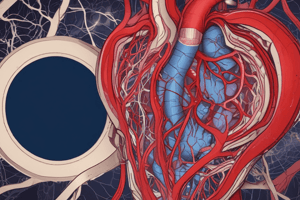Podcast
Questions and Answers
როგორი მაკროსკოპული ცვლილებები ვითარდება სისხლძარღვებში გართულებულიათეროსკლეროზის დროს ?
როგორი მაკროსკოპული ცვლილებები ვითარდება სისხლძარღვებში გართულებულიათეროსკლეროზის დროს ?
- ანთება, ათეროკალცინოზი, თრომბოზი
- წყლული, ნაწიბური, კალცინოზი
- სისხლჩაქცევა, თრომბოზი, წყლული (correct)
- ჰიალინოზი, ათერომატოზი, ათეროკალცინოზი
რომელი ჰემოდინამიური ფაქტორები მონაწილეობენ ათეროგენეზში:
რომელი ჰემოდინამიური ფაქტორები მონაწილეობენ ათეროგენეზში:
- არტერიული ჰიპერტონია, სისხლმილთა ასაკობრივი ცვლილება
- არტერიული ჰიპერტენზია, სისხლმილთა განვლადობის მომატება (correct)
- სისხლმილთა განვლადობის შემცირება, ჰიპერკოაგულაცია
- სისხლმილთა კედლის გაჟღენთა პლაზმური ცილებით (პლაზმორაგია)
რომელი ჰორმონული ფაქტორები უშლის ხელს ათეროსკლეროზის განვითარებას ?
რომელი ჰორმონული ფაქტორები უშლის ხელს ათეროსკლეროზის განვითარებას ?
- ჰიპერკორტიციზმი, ანდროგენები
- შაქრიანი დიაბეტი, ჰიპოთირეოზი
- ჰიპერთირეოზი, ესტროგენები (correct)
- უშაქრო დიაბეტი, ჰიპერალდოსტერონიზმი
რომელი ავადმყოფობების საფუძველია კორონალური არტერიების ათეროსკლეროზი ?
რომელი ავადმყოფობების საფუძველია კორონალური არტერიების ათეროსკლეროზი ?
ცერებრული არტერიების ათეროსკლეროზის შედეგად ვითარდება თავის ტვინის ქრონიკული,ხანგრძლივი იშემია, რასაც მოჰყვება:
ცერებრული არტერიების ათეროსკლეროზის შედეგად ვითარდება თავის ტვინის ქრონიკული,ხანგრძლივი იშემია, რასაც მოჰყვება:
რა ვითარდება თირკმლის არტერიების ათეროსკლეროზის დროს ?
რა ვითარდება თირკმლის არტერიების ათეროსკლეროზის დროს ?
ბარძაყის არტერიის მასტენოზებელი ათეროსკლეროზის დროს ვითარდება:
ბარძაყის არტერიის მასტენოზებელი ათეროსკლეროზის დროს ვითარდება:
უპირატესად სად ვითარდება ესენციური ჰიპერტენზიისთვის დამახასიათებელიპათომორფოლოგიური ცვლილებები ?
უპირატესად სად ვითარდება ესენციური ჰიპერტენზიისთვის დამახასიათებელიპათომორფოლოგიური ცვლილებები ?
არტერიოლების სპაზმის დროს მათში აღინიშნება:
არტერიოლების სპაზმის დროს მათში აღინიშნება:
ჰიპერტონული ავადმყოფობის დროს კარდიომიოციტებში დინამიურად ვითარდება:
ჰიპერტონული ავადმყოფობის დროს კარდიომიოციტებში დინამიურად ვითარდება:
Study Notes
Macroscopic Changes in Blood Vessels During Complicated Atherosclerosis
- Thickening of the arterial wall occurs due to plaque accumulation.
- Lumen narrowing leads to reduced blood flow, affecting oxygen delivery to tissues.
- Formation of fibrous caps adds to the rigidity of blood vessels.
Hemodynamic Factors in Atherogenesis
- Hyperlipidemia contributes significantly to the development of atherosclerosis.
- Shear stress from turbulent blood flow can damage endothelial cells.
- Blood pressure fluctuations play a crucial role in vascular injury.
Hormonal Factors That Inhibit Atherosclerosis Development
- Estrogen is known to provide protective effects against atherosclerosis in premenopausal women.
- Insulin sensitivity is enhanced, helping regulate lipid metabolism and reduce plaque formation.
- Various anti-inflammatory cytokines can mitigate arterial inflammation.
Diseases Associated with Coronary Artery Atherosclerosis
- Atherosclerosis is a primary contributor to coronary artery disease (CAD).
- Conditions like hypertension, diabetes mellitus, and familial hyperlipidemia escalate risk factors.
Consequences of Cerebral Artery Atherosclerosis
- Leads to chronic brain ischemia, which can result in cognitive impairment and stroke.
- May cause transient ischemic attacks (TIAs) due to intermittent blood supply interruptions.
Developments in Renal Artery Atherosclerosis
- Can lead to renal ischemia, resulting in hypertension and renal failure.
- Progression causes fibrosis and scarring of renal tissue, impacting kidney function.
Results of Atherosclerosis in the Femoral Artery
- Causes claudication, a condition where leg muscles experience pain during exertion.
- Can lead to critical limb ischemia, risking amputation if untreated.
Pathomorphological Changes in Essential Hypertension
- Primarily manifest as hyaline arteriosclerosis, which affects small blood vessels.
- Replacement fibrosis and narrowing of lumen in large arteries due to pressure overload.
Observations During Arteriolar Spasm
- Reduction in blood flow and oxygen supply to tissues occurs.
- Elevated levels of vasoconstrictor substances are usually detected within the arterioles.
Cardiac Myocyte Changes in Hypertensive Conditions
- Cells exhibit hypertrophy as a response to increased workload.
- Alterations in myocyte structure can lead to functional impairment and heart failure.
Studying That Suits You
Use AI to generate personalized quizzes and flashcards to suit your learning preferences.
Description
Learn about the macroscopic changes that occur in blood vessels during atherosclerosis, a condition characterized by the buildup of plaque in artery walls. This quiz covers the pathological changes in blood vessels and their implications. Test your knowledge of atherosclerosis and its effects on blood vessels.



